MY "AMERICAN FLYER" EXPERIENCE
Boyhood: Real American Flyer
Adulthood: Nostalgia Sets In
Except where otherwise noted,
American Flyer S-gauge items displayed on this page were photographed by the
author at local model train shows.
We are grateful to other photographers and collectors whose work is also displayed
here in reduced resolution.
We urge viewers to view the original works at their outstanding websites.
If you've come to this page hoping to find information about luggage
or bicycle racing, sorry, it's not that kind of "American Flyer." If
you've wandered onto this page with no idea of what "American Flyer" has
signified in the minds and hearts of American kids since the 1930s through the
1960s, even until
well after these kids have grown old, think: "like Lionel trains—only different."
For more in-depth background, you might want to switch to the branch line to "Notes
on American Flyer Trains" before proceeding. But if you've heard of A. C. Gilbert, if you know what "S-scale"
means, and if you can tell a Geep from a Hudson, you're clear and green to
highball down the main! ▼
However, if you're more
interested in the result than in the process,
click here to take the
cutoff to the
current Faux Flyer page.
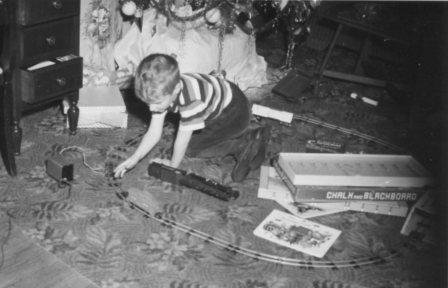
Yes, I'm what you might call a serious modeler.
So what the heck am I
doing with these toys?
Well, once upon a time I was a kid.
And more than half a century later, part of that kid is still living happily
ever after.
It's like this...
ON THIS PAGE
I. The Fever Strikes at Yuletide
Real American Flyer, 1950-1960
Intermission
II. Circling the Tree Again
The "Hand-Me-Down" Phase, 2009-2010
III. The Yule Tree Vanishes
The "Prototypes" Phase, 2011-2012 (with video)
IV. A Shift of Perspective
The "Flyer Look-Alike" Phase, 2013
Sites for Those Who Demand Genuine American Flyer
Notes on American
Flyer Trains
Episode I: The Fever Strikes at Yuletide
I get my first electric train set for Christmas
in 1950, when I'm six, and still an only child. It's a basic American Flyer S-gauge set-up,
comprising a simple loop of track, a locomotive and tender, two freight cars,
and a caboose. "Wow, thanks,
Santa!" I'll probably get more mileage out of this than any other plaything
(with the possible exception of my phonograph) until I get my first bike.
|
1950
My first electric train set
includes the following...

#300 Reading "Atlantic" type (4-4-2) steam
locomotive and tender
(Photo courtesy of
The Gilbert Gallery)
|

#628 Chicago & Northwestern flat car with log load
(Photo by author at Dayton Train
Show, 2014) |

#633 Baltimore & Ohio box car
(Photo by author at Dayton Train
Show, 2014) |
|

#630 Reading illuminated caboose
(Photo courtesy of
The Gilbert Gallery)
...plus a
single loop of track and a 75-watt transformer.
|
The next year, the simple loop of track acquires
two switches and a passing siding, made necessary by the addition of some
passenger cars.
|
1951
Passenger service commences...


#651 New Haven baggage car and #650 New Haven illuminated coaches (3)
(Photos courtesy of
The Gilbert Gallery)
To handle
the increased electrical load of the switches and
illuminated cars, the transformer is upgraded to a 100-watt unit.
|
|
1952
Well-to-do passengers can
now opt for Pullman service...

#654 Pullman illuminated observation car
(Photo courtesy of
The Gilbert Gallery) |
|
...and the freight fleet expands
by three more cars... |

#629 Missouri Pacific cattle car (#929 shown)
(Photo by author at Dayton Train
Show, 2014) |

#637 Missouri, Kansas & Texas box car (#937 shown)
(Photo by author at Dayton Train
Show, 2014)
When he was doing his "Santa shopping," my
grandfather apparently couldn't find a refrigerator car on the store
shelf. So, since I already have a box car, he presents this yellow
"Katy" box car to me as a "refrigerator car."
Having just turned eight, I've never seen the icing hatches on refrigerator car roofs,
so I don't yet know the difference between a yellow box car and a yellow
reefer, Everything's cool.
|

#631 Texas & Pacific gondola (#931 shown)
(Photo by author at Dayton Train
Show, 2013) |
The rapidly filling loop of track expands and
moves to a permanent site in the basement. When I get back from my
summer vacation with my grandparents, Dad presents me with my first two-wheel
bike. That evening, I ride slowly up the street, with Dad jogging
alongside and hanging onto the seat. At the intersection, we stop to
turn around and start back. When I get back to our house, I suddenly
realize Dad's no longer alongside, so I guide into the soft grass (there are
no curbs here), hit the brake, and bail out. (It's a 26-inch bike, and
I'm still a bit small for it, so I'll have to ad-lib mounting and dismounting
for a while.) Well, it looks as though I have a warm-weather diversion
from the railroad. But as autumn takes hold, it turns chilly again, and
it's back to the cellar.
|
1953
For my birthday this year, Dad
manages to acquire second-hand from a friend...
...a bigger locomotive...

#314 Pennsylvania "Pacific" type (4-6-2) steam
locomotive and tender
(Photo courtesy of
The Gilbert Gallery)
...along
with a few more passenger cars...


#651 New Haven baggage car (#951 shown) and #650 New Haven illuminated
coaches (2)
(Photos courtesy of
The Gilbert Gallery)
...plus a
boom tender car...

#645 work & boom car
(Photo courtesy of
The Gilbert Gallery)
...but no
crane with a boom to tend!
|
Christmas is a bit lean for our family in 1954.
With a baby sister on the way, my parents have just made the down payment on a
two-story house across town, and we move in just before Christmas. I've
been granted rights to roughly half the attic to re-establish my railroad
empire, and I'm so busy tacking down and testing the new track (on the bare
plank floor), that I don't even notice there are no new cars under the tree
this year.
|
1955
This Christmas, two more freight
cars appear under the tree... |
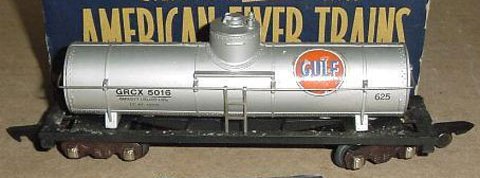
#625 Gulf tank car
(Photo courtesy of
The Gilbert Gallery) |

#632 Lehigh & New England hopper car
(Photo courtesy of
The Gilbert Gallery) |
...thus rounding out my collection of the eight
basic freight car types.
Since Flyer had discontinued production of
link couplers after 1953, these two cars were either used or surplus.
I suspect the latter, since they were in mint condition upon arrival. |
At age 11 or 12, I begin riding my bike to the local railroad
yards to watch the real trains, and it occurs to me that my
S-gauge toys
are rather crude-looking. Equipment available in smaller
HO scale
looks much more realistic, being both more accurately proportioned and better
detailed. So, in the late 1950s, I trade in the American Flyer and start
over in HO. I've been in that scale ever since.
Intermission
A four-year break in my model railroading pastime was imposed by my
enlistment in the army, during which a certain young lady and I met and
subsequently committed matrimony. After my discharge from the service,
we moved into an apartment for a few years until we'd saved enough to afford a
down payment on a house. The dwelling we chose was ideal. It had a
splendid 1,200-square-foot (110-square-meter) cellar, and was located just half a
city block from my
favorite hobby shop. (The above-ground part wasn't bad either.) In the
years since, a few layouts have been planned, partially built, and then
(except for the current layout) replaced when a new
concept occurred to me. A small, portable layout, also
in HO scale, was built to run under the Yule tree, ostensibly for the amusement of our daughter and our cat,
but also to satisfy my own nostalgic impulse.
Still, when I attended model train shows each fall, I felt drawn to the
American Flyer swap tables and operating layouts. There was still
something about that clunky toy stuff that claimed some child's corner of my
heart—and I'd like to think it wasn't just the sharp ozone smell from the old
open-frame motors! So, for a few years I entertained the idea of
acquiring some used Flyer equipment to replace the HO under-tree layout.
But there was always some reason to put it off—not the least of which being the
practical difficulty of locating parts for equipment that had been run to death by kids
and then stored for years in damp basements or dusty attics.
Episode II: Circling the Tree Again
Then it struck me. To get the American
Flyer ambience, I needn't buy (and refurbish and maintain) antique equipment,
or even switch the portable layout from HO to S gauge. I could simply
use HO models of the same engines and cars after which the Flyer toys had been
patterned. And when the little loop of track goes back into storage
after the winter holidays, any equipment that conforms to "model" quality can
continue in operation the rest of the year on the permanent layout in the
cellar. This being both the much less daunting and more affordable
option, I took the plunge.
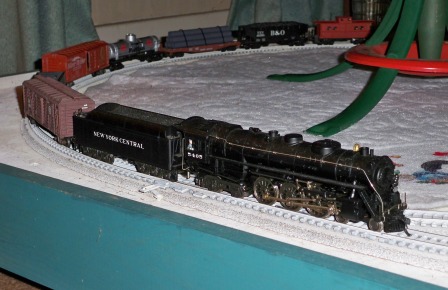
Hey, under the tree, this stuff could actually be mistaken for American Flyer
(or Lionel)—if you don't look too closely!
2009-2010: The "Hand-Me-Down"
Phase
The Faux Flyer project is initially conceived as a minimum-budget
operation. Where possible, I use equipment that I have on hand, or
can obtain cheaply at auctions or swap meets, more or less as-is except
for standardizing couplers. I want to represent, in HO scale, each
of the main types of freight and passenger cars made by American Flyer
between 1950 and 1957.
In 2009, I concentrate on the
freight fleet. American Flyer's freight car line included eight basic
types: box cars, flat cars, gondolas, hopper cars, refrigerator cars,
stock cars, tank cars, and cabooses. I'm able to scrounge HO
representatives of most of
these from my junk bin and from the previous Yule-tree collection.
These include toy-grade and low-model-grade cars from my own and my
grandfather's collections, which is for various (mostly aesthetic)
reasons unsuitable for operation on the scale-model layout in the
cellar. This satisfies requirements for a box car, a gondola, a
hopper car, a refrigerator car, a stock car, and a caboose. I
purchase a new tank car and flat car to round out the freight fleet, and
load the flat with a load of six pipes to achieve the general look of
Flyer's "log car." I check all equipment for proper rolling
qualities and convert all couplers to Kadees.
|

Rivarossi-Lionel MP stock car
(redecorated from original MKT, from discard box)
|
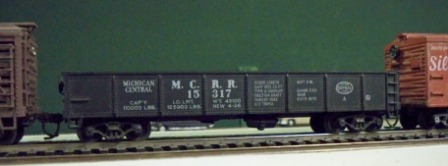
Rivarossi-Lionel MCRR gondola
(original, from discard box)) |
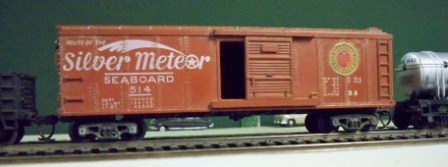
Gilbert-HO SAL "Silver Meteor" box car
(original, from discard box) |
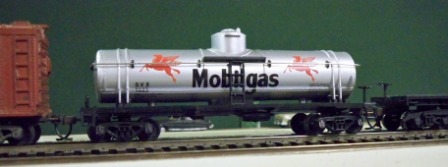
Mantua SVX "Mobilgas" tank car
(original, from main fleet) |
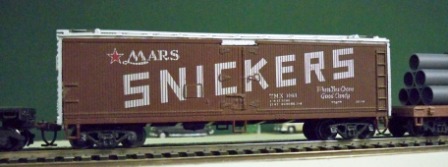
Athearn TMX "Snickers" refrigerator car
(original, from discard box) |
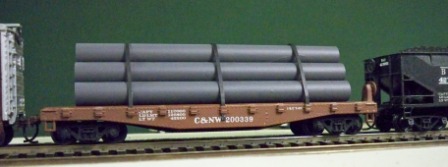
Athearn C&NW flat car with pipe load
(relettered from CN, new kit) |
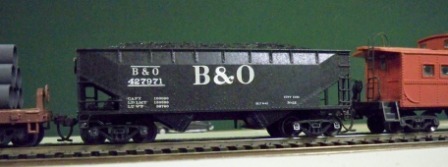
Athearn B&O hopper car
(redecorated, from main fleet) |
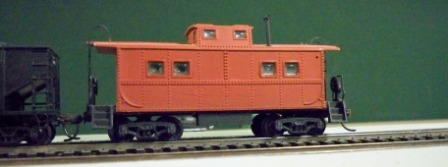
Varney caboose
(from discard box) |
Except for the Gilbert-HO "Seaboard" box car and the Varney caboose,
most of these cars don't look much like American Flyer cars, either in
physical detail or in the road names they bear. But for the time
being, all
I'm after is a general ambience, not details.
For motive power, I purchase a used Rivarossi NYC Hudson on eBay. It's
a sort
of toy-model crossbreed with good detail, but with noticeably
oversize ("pizza-cutter") wheel flanges typical of European models of the 1960s. An
HO model of New York Central's class J-3a Hudson, it closely resembles
American Flyer's S-scale model of the same locomotive. After a
couple of minor repairs, a lube job, and a run-in, it's ready to go.
The only problem is that, behind this big engine, only seven of the
freight cars will fit on the passing siding of the little under-tree
layout. So, I just swap a couple of cars every day or two for
variety.
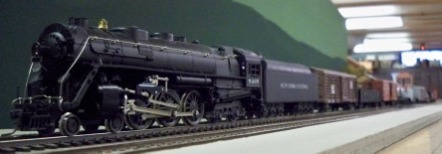
The full freight train poses on the big cellar layout
in 2009.
|
American Flyer had made
standard-design passenger cars, available in either green or red, since
the 1930s. But in 1950, the company introduced a four-car streamlined
set, comprising a baggage-club combine, a coach, a vista dome car, and a
round-end observation car. In 2010, continuing the
"Hand-Me-Down" theme, I acquire a couple of Athearn streamliners: an
r.p.o. (railway post office) car and an observation car, from an estate
liquidation table at a swap meet. The following year, a coach
joins the set. Unfortunately, only two of the streamliners will
fit behind the Hudson on the tree layout, so the full passenger set can
operate only on the main layout.
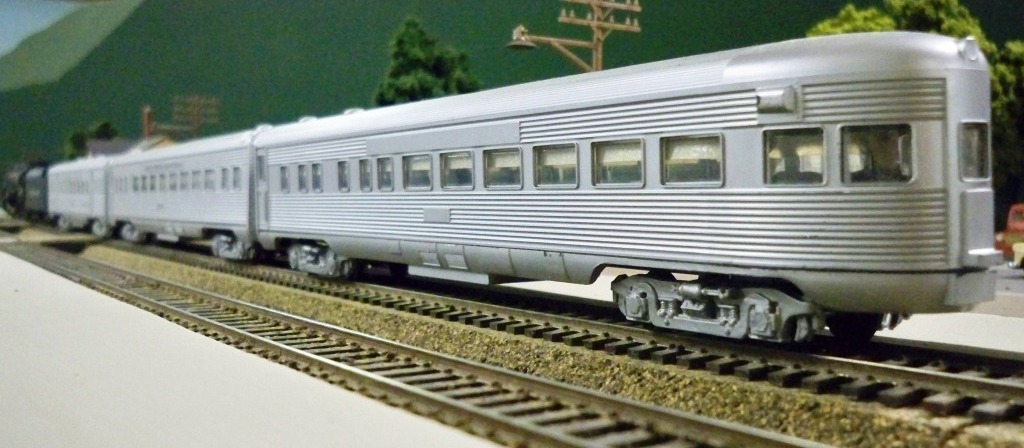
Since I now have two trains, I need another locomotive to haul one of
them. So, back to the discard box. Here I find a GP-7 in
Baltimore and Ohio's passenger colors. Though it had still run
well, this engine had been removed from service on the big layout when I acquired a more accurately
proportioned
Kato unit.
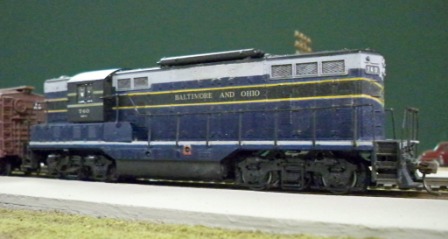
Athearn GP-7 in its original Baltimore and Ohio passenger scheme.
(As on some other railroads, B&O had its early Geeps configured to run
long-hood forward.)
When new, this Athearn model
had had a dynamic brake pod and a winterization hatch. I'd removed
these in order to install the roof-mounted "torpedo boat" air tanks
and three-chime horn appropriate to
B&O passenger-service Geeps.
Now, here's a matter of practical consideration.
As mentioned before, there isn't
room on the tree layout to run
the full eight-car freight train behind the Hudson.
But because the GP-7 is shorter by about the length of
the Hudson's tender, the Geep can comfortably haul the full freight
train without spilling over the bounds of the passing track.
Meanwhile, the Hudson looks mighty sharp heading up those silver
streamliners, despite their two-car limit on the tree layout. So that becomes the going plan.

The Yule-tree layout in 2010—with tracks
already filled to capacity!
Since the Geep is shorter than the Hudson, I can
now add the eighth car to the under-tree freight drag—with a centimeter or two to spare!
In passenger service, however, the big Hudson is limited to two cars—not
because it can't haul more, but because more just won't fit on the siding!
|
As it stands, the little railroad appears to have
reached its rolling-stock capacity.
Episode III:
The Yule Tree Vanishes
In 2011, we acquire a new
kitty, a bouncing boy named Tippy. In one way this is good,
because he's decidedly healthy, in contrast to his recently deceased
predecessor, who had been puny for all of his 11 years and very sickly for the
last two or three. On the other hand, the new kitty is both far more active
and far more massive (already weighing around 5 kilos [11 pounds] before his
first birthday), and is
a boisterous ball of kinetic energy. Consequently, we've been unable to put up a
Yule tree since we've had Tippy, and the Faux Flyer equipment must be
confined to the cellar, from which he is banned.
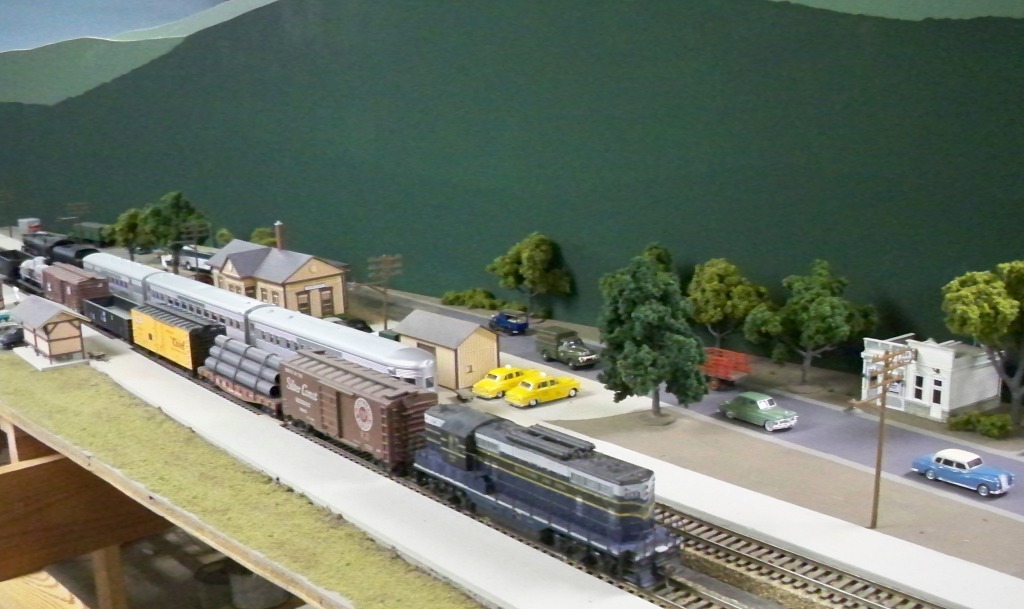
The current arrangement
(until, if ever, Tippy mellows out) is for the Faux Flyer equipment to be
operated on the cellar layout during the winter holiday period, and stored the
rest of the year. Still, there's a positive opportunity inherent in all
this. So long as the cat never the train shall meet, I'm free to substitute somewhat more
costly and delicate
equipment more closely resembling items in the old American Flyer roster.
|
2011-2012: The "Prototypes" Phase
An upgraded fleet stretches its legs on the big cellar layout.
With the Faux Flyer equipment transplanted to an environment that's
both less hazardous and more brightly illuminated, it occurs to me that
this hodge-podge of cast-off cars might be replaced with better quality
models of the specific prototypes of Flyer equipment. I could, for
example, replace the Lionel-HO toy Michigan Central gondola with a
finely detailed Accurail model of the Texas and Pacific car modeled by
Flyer, but in prototype black rather than Flyer's coach green. And
that composite "Snickers" reefer has got to go. And I'd love to
lay my hands on a gray LNE hopper car, if I can find one. And, of
course, that now lone toy Seaboard box car will be way out of place with model
equipment. So...
|
| These
"hand-me-downs"... |
...are
replaced by these models of "prototypes"... |
...on which these S-gauge American Flyer cars were based. |

Gilbert-HO #514 box car; "Silver Meteor" SAL |
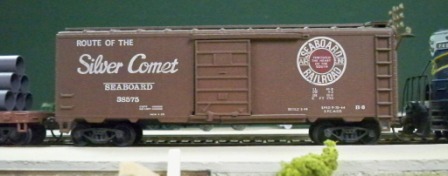
Roundhouse 40' box car; "Silver Comet" SAL 38575
(original,
budget model, kit) |
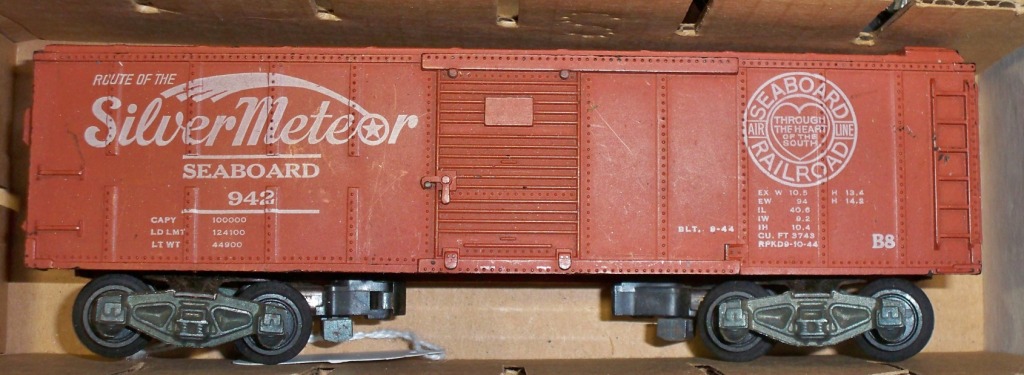
AF
#642 / 942 Seaboard "Silver Meteor" box car |
|
Athearn flat car, CN
I hadn't
used or photographed the Athearn flat car kit in its original
Canadian National livery. I'd simply relettered portions of the car for a CNW
prototype before building the kit, so, it was already in "prototypes" mode from the outset. |

Athearn 40' flat car, CNW 200339
(relettered,
budget model, kit) |

AF #628 / 928 Chicago & Northwestern "log car" 42597 |

Lionel-Rivarossi gondola, MCRR 15317 |
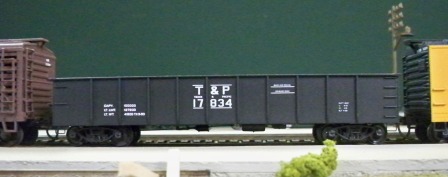
Accurail 40' fixed-end gondola; T&P 17834
(original,
high-grade model, kit) |

AF #631 / 931 Texas & Pacific gondola |

Athearn offset-side hopper, B&O 427971 |
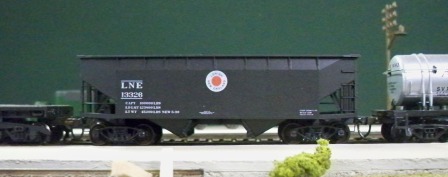
Accurail 34' offset-side hopper, LNE 13328
(original,
high-grade model, kit) |

AF
#632 Lehigh New England offset-side hopper car
(Photo:
http://www.thegilbertgallery.org) |

Athearn composite reefer, "Snickers" TMX 1068 |
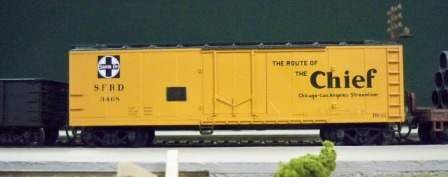
Trainline 40' plug-door reefer, "Chief" SFRD 3468
(redecorated,
budget model, used) |

AF #647 / 947 Northern Pacific plug-door refrigerator car |
|

Lionel-Rivarossi stock car; MP 53180
I hadn't photographed
the Lionel-Rivarossi stock car in its original MKT "Katy" colors
(yellow and black, as I recall). |

Lionel-Rivarossi stock car; MP 53180
(redecorated,
toy, r-t-r)
I currently know of no available model closely
resembling Flyer's composite "cattle car" design. But the Lionel-Rivarossi
car at least has prototype paint and markings. |

AF #629 / 929 Missouri Pacific "cattle car" |

Mantua tank car, "Mobilgas" SVX 1443 |

Mantua tank car, "Mobilgas" SVX 1443
(original,
toy, r-t-r)
So far unable to locate an HO car more closely
resembling Flyer's Gulf tanker, I retain
Mantua's Mobilgas car. |

AF #629 / 929 Gulf tank car GRCX 5016
(Photo:
http://www.thegilbertgallery.org) |

Varney caboose |

Varney caboose
(undecorated,
budget model, used)
The Varney caboose is retained as a suitable
prototype model, but remains unlettered for now. |

AF #630 Reading caboose
(Photo:
http://www.thegilbertgallery.org) |
While Faux Flyer is in its "Prototypes" phase, it occurs to me that there are
items in my existing model roster corresponding to other American Flyer
equipment. So, as long as it's being operated on the big cellar layout,
any or all of these cars may be added to a Faux Flyer freight train if
desired.
| These HO models... |
...roughly correspond to these
American Flyer S items. |
| Accurail
Central of New Jersey PS-2 covered hopper car, CNJ 771 |
AF #624 / 924 CRP
cement car |
|
Bachmann Erie 12-wheel depressed-center flat car, ERIE 7268 |
AF #636 ERIE 7210 depressed-center flat car with wire reel load |
|
Athearn Great Northern AAR box car, GN 50324 |
AF #913 GN "Glacier National Park" ARA box car |
|
 |
|
Athearn Baltimore & Ohio AAR box car, B&O 467439 |
AF #980 B&O "Time-Saver" ARA box car |
|
Athearn Bangor & Aroostook AAR box car, BAR 5206 |
AF #982 BAR "State of Maine Products" ARA box car |
|
Accurail New Haven PS-1 box car, NH 36570 |
AF #984 NH (orange billboard) ARA box car |
|
Athearn Chicago & Northwestern swing-door reefer, NWX 751 |
AF #989 NWX "Northwestern Refrigerator" plug-door reefer |
|
 |
Below, an aerial view of Haydn Place on the cellar layout shows the westbound
Flyer streamliner pausing at the depot to take on passengers while the freight
rumbles eastward toward the bridge to New Bobhart. Note the inclusion of
a couple of cars—a depressed-center flat and a covered hopper—from the main
roster to represent additional American Flyer car types.
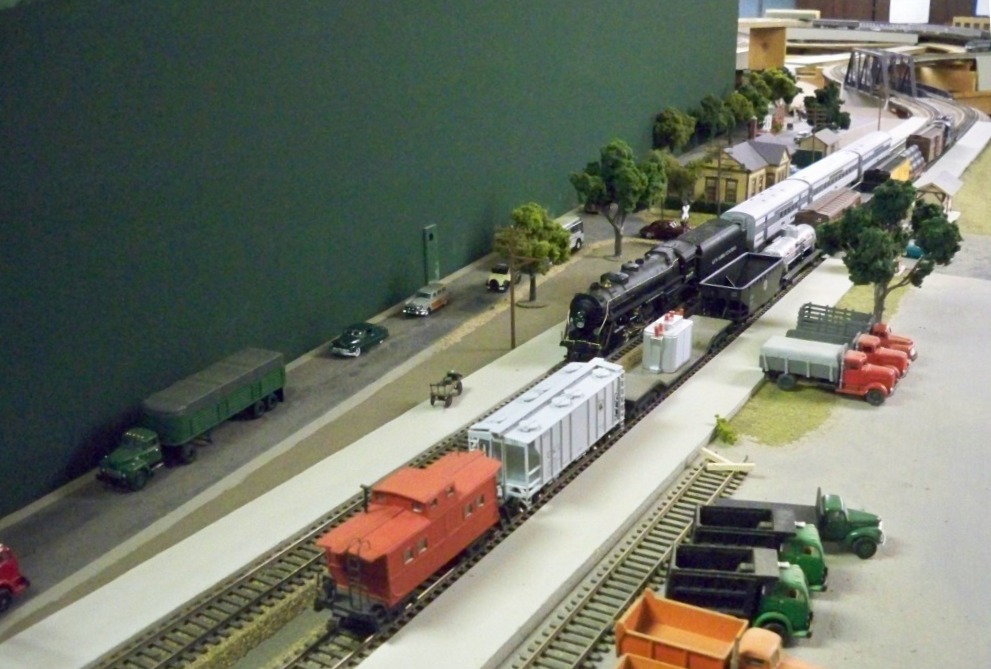
Episode IV: A Shift of
Perspective
After intermittently doing the Faux Flyer project over four years, I came to realize that
what I really crave is not so much to model American Flyer's prototypes, but
rather to replicate the S-gauge equipment itself in HO—right down to Gilbert's
sometimes goofy, non-prototypical paint schemes—the more convincingly to
recall the days of my budding passion six decades earlier, and my boyhood
dreams of watching my own S-gauge equipment scaled-up and running through our
town on real tracks.
So, the roster undergoes another revision. In some cases, this entails
only new paint and lettering, but in others it means acquiring equipment
specifically to replicate Flyer's S-gauge cars in HO. So, the plans to
use hand-me-down equipment and real-world prototypes fade out, replaced by a
march of materialized memories straight from my own past.
|
2013 to present: The "Flyer Look-Alike"
Phase
Let's try a little experiment. See if you can identify
the items in the following photos:
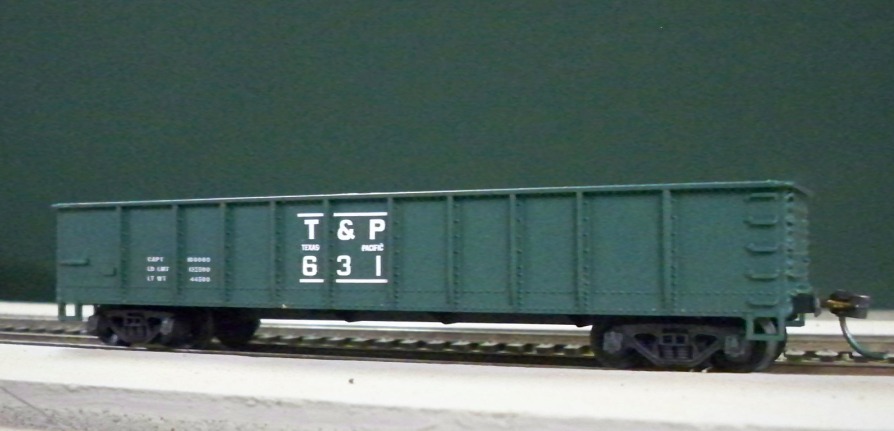


Well, it's easy to tell what they
are not.
[1] Prototype equipment from real railroads? Obviously not!
They're too clean for that!
[2] Accurate models? Any serious model railroader can see they are not. The colors and numbers are all wrong.
[3] American Flyer S-gauge cars? At first glance, an enthusiast
might recognize the freaky-but-familiar color schemes of American Flyer circa
1950. But on closer inspection, he'd note the details and proportions
are not as crude as those of Flyer's toy roster.
[4] If I tell you they're HO scale, you might guess they're Gilbert HO.
But that would still not be right.
So, what's going on here?
What I had in 2013 was a
collection of models of the same prototypes my childhood toys had
represented six decades earlier. What I really craved was the toys
themselves! Or at least something that looked very much like them, but
would operate on the HO-gauge track I already had. Hm. That
would take some imagination and research, many hours of tedious work, a few
more purchases than I'd initially figured for this project, as well as an attitude
overhaul about the value of "toys." So...
Everything
new is old again!

It's getting to look more like the Flyer I remember! But with
some improvements.
Click here to go to the
current Faux Flyer page!
|
But wait! Are you wondering what
happened to the equipment from the "Hand-Me-Down" and "Prototypes" phases?
If so, read on.
Long story short: Most of the
toy-quality items have been retired. (But not trashed. They can be restored to service if
desired.) The model-quality equipment is still in operation, either in
the main model roster or in the Faux Flyer fleet, though some items have been—shall
we say—"transfigured."
Short story long: The toy-quality cars of the original
"Hand-Me-Down" phase that have been removed from service include the Lionel-Rivarossi MCRR gondola and MP
stock car, the Mantua "Mobilgas" tank car, and the veteran
Gilbert-HO "Silver Meteor" box car.
Of the model-quality cars, most of
the "Prototypes" phase equipment has returned to model status on the big
layout—more or less permanently, but available for Faux Flyer service if
desired. The composite reefer bearing the toy-like "Snickers" banner has
been redecorated as Santa Fe "Grand Canyon"
reefer 31254, with the SF system map displayed on the reverse side, and is now
promoted to the big layout's model roster.
 ►
►


The Trainline "Chief" reefer was
replaced in the model fleet by a new Accurail SFRD "Super Chief" plug-door
car. So what happened to the Trainline car? It migrated in the
opposite direction, to the Faux Flyer fleet, where it's now doing a fairly
convincing impersonation of American Flyer's #647 Northern Pacific reefer.
Along with certain other items that have been redecorated in Flyer colors.
Plus a few new items acquired with Faux Flyer service specifically in mind.
Want to see?
Click here to go to the
current Faux Flyer page!
▲
RETURN TO THE TOP OF THIS PAGE













































